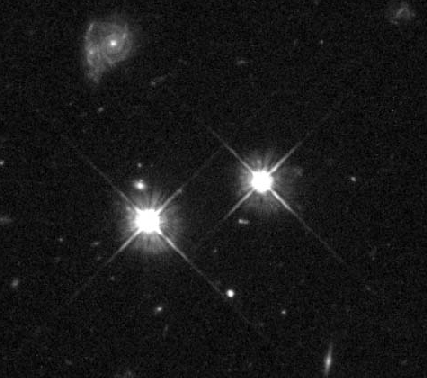Astronomy Picture of the Day
Discover the cosmos!
Each day a different image or photograph of our fascinating universe is
featured, along with a brief explanation written by a professional
astronomer.
August 18, 1996

A Milestone Quasar
Credit:
C. Steidel
(Caltech),
HST,
NASA
Explanation:
Here is a rather typical quasar. But since
quasars
are so unusual it is quite atypical of most familiar objects. Of the two
bright objects in the center of
this photo,
the quasar is on the left. The bright image to
quasar's right is a star, the faint object just above the quasar is an
elliptical galaxy, with an apparently
interacting pair of spiral galaxies near the top.
Quasars appear as unresolved points of light, as do stars, and hence
quasars were thought to be a type of
star until the 1960s.
We now know that the brightest quasars lie far across the
visible
universe from us, and include the most distant objects known. Quasars
may occupy the centers of galaxies
and may even be much brighter than their host galaxies. In fact, the
centers of many nearby galaxies have similarities
to quasars - including the
center of our own Milky Way Galaxy. The exact
mechanism responsible for a
quasar's
extreme brightness is unknown, but thought to involve
supermassive black holes. This picture represents a
milestone for
the six-year-old
Hubble Space Telescope
as it was picture number 100,000, taken on June 22, 1996.
Tomorrow's picture: Welcome to Planet Earth
| Archive
| Index
| Search
| Glossary
| Education
| About APOD |




Authors & editors:
Robert Nemiroff
(MTU) &
Jerry
Bonnell (USRA).
NASA Technical Rep.:
Sherri
Calvo.
Specific rights apply.
A service of:
LHEA
at
NASA/
GSFC




